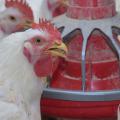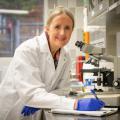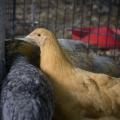Solutions and Treatments
The following solutions have been used as supportive treatments by poultry and game bird producers. They are intended as aids in treating the described conditions, not as a replacement for any management, drug, or antibiotic therapy.
ASPIRIN SOLUTION
Used as a general treatment for reducing distress conditions of birds (fever or listlessness) that accompanies many diseases.
Dissolve five (5 grain) aspirin tablets in one gallon of water.
Offer this solution free-choice to the birds for the duration of an illness. The solution aspirin equivalent to 25 grains/gallon or 324 mg/gallon of drinking water. The dosage rate is about 25 mg/lb body weight per day.
ASTRINGENT SOLUTION
This solution can be used to treat young birds that show non-typical disease symptoms of poor growth. The solution can also be given to birds suffering from respiratory diseases that produce a large amount of mucus exudate. This solution will help "cut through" the mucus and allow it to be expelled easier.
Two quarts of apple cider vinegar diluted into 100 gallons of water
(4 teaspoons/gallon)
The tannin in the apple cider vinegar aide in removing any mucus or coating from the mouth, throat, or intestinal tract. Nutrients and drugs are more readily absorbed. Offer this solution as the only drinking water source for two to three day intervals.
COPPER SULFATE SOLUTION
Use this solution as a treatment for mycosis (mold infection) in the crop. An alternate name for the condition is "Thrush." Use the solution as a "follow-up" treatment after flushing with epsom salt solution--refer to the section for LAXATIVE SOLUTIONS.
Dissolve .5 lb copper sulfate and .5 cup vinegar into 1 gallon of water for a "stock" solution. Dispense stock solution at the rate of 1 oz per gallon for the final drinking solution.
An alternate method of preparing the solution is:
dissolve 1 oz copper sulfate and 1 tablespoon of vinegar into 15 gallons water.
Use either solution as the sole water source during the course of the disease outbreak. Copper sulfate is often referred to as "bluestone".
EGG DIPPING SOLUTION
This procedure has been used to destroy pathogenic organisms such as Mycoplasma spp. that can be carried on the hatching eggs. The procedure must be conducted exactly as described, and is not intended as a routine hatching egg treatment. The procedure is only used in unusual situations.
The antibiotic solution contains 500 ppm gentamycin sulfate
(1 gram per 2 liters of water) or 1 gram tylosin per liter of water.
The hatching eggs must be carefully washed, rinsed, and sanitized prior to treatment. The eggs are then prewarmed to 100 degrees F. for 3-6 hours and immediately submerged into the antibiotic solution that has been previously cooled to 60 degrees F. The eggs are left in the antibiotic solution for 15 minutes before being placed into the incubator.
After each day's use, the solution must be sterilized by heating to 160 degrees and maintained for 10 minutes. Any water lost during sterilization must be replaced. Refrigerate the solution in a clean covered container between uses to prevent bacterial contamination. Do not use or store solutions for more than three days after dilution.
FUMIGATION OF HATCHING EGGS AND EQUIPMENT
Preincubation of hatching eggs and equipment
Mix .6 gram potassium permanganate (KMnO4) with 1.2 ml formalin for each cubic foot of space.
-or-
2 oz KMnO4 and 4 fl oz formalin per 100 ft3 space.
Mix both ingredients in an earthenware or heat resistant container having at least ten times the capacity of the ingredients being added. Circulate the gas for 20 minutes at 70 degrees F. or higher. Equipment without eggs can be allowed to fumigate overnight before exhausting the formaldehyde gas.
Fumigating eggs in incubator
Mix .4 gram KMnO4 and .8 ml formalin per ft3
-or-
1.5 oz KMnO4 and 3 fl oz formalin per 100 ft3
Follow the same guidelines as discussed for equipment fumigation. Do not fumigate chicken eggs between the 24th and 96th hours of incubation. Other species of birds may need the incubation intervals adjusted to compensate for total incubation time in relationship to the chicken's incubation period. It is best to incubate after the incubator reaches normal operating temperature and humidity.
LAXATIVE SOLUTIONS
The following solutions or mixtures are recommended to flush the digestive system of toxic substances, most notably for treating birds exposed to botulism toxins.
Molasses Solution
Add one pint of molasses to 5 gallons of water
Offer the drinking solution free-choice to the affected birds for about four hours. Treat severely affected birds individually if they cannot drink. Return the birds to regular water after the treatment period.
As a supportive treatment for symptoms resulting from Cryptosporidia infection, often referred to as coronaviral enteritis, use:
One quart molasses in 20 gallons of water
Offer this solution free-choice for a period of up to 7-10 days. It is assumed that the molasses replaces certain minerals lost from diarrhea during the course of the infection.
Epsom Salt Solution
1 lb Epsom Salt per 15 lb feed
-or-
1 lb Epsom Salt per 5 gallons water for 1 day
Give the epson salt feed mixture as the sole feed source for a one day period. This feed can be used only if the birds are eating. If the birds are not eating, use the water solution. If the birds are unable to eat or drink by themselves, use individual treatment with:
1 teaspoon of Epsom Salt in 1 fl oz water
Place the solution in the crop of the affected bird. This same amount of solution will treat 5-8 quail or one chicken.
Castor Oil Therapy
Dose individual birds with .5 oz castor oil.
NUTRIENT SOLUTIONS
The following solutions can be used as supplements to diets that are deficient in certain amino acids, energy, or vitamins and electrolytes. They are used only as temporary additives and not intended as part of a regular feeding program.
Amino Acid Solution
100 grams (7 fl oz) dl-methionine and 110 grams (6 fl oz) l-lysine HCl dissolved in 50 gallons water
-or-
2 grams (.8 tsp) dl-methionine and 2.2 grams (.7 tsp) l-lysine HCl in one gallon of water
Offer the solution free-choice to the birds as an aide to reducing the depressing effects of low-protein diets. Make up a fresh solution daily and offer to birds in clean waterers. All measurements in parentheses () are volumetric measurements while those expressed in grams are weight measurements.
Sucrose Solution
10 ounces of granulated sugar per gallon of water
This solution may be given as an energy treatment for weak chicks. Offer the solution as the only water source for the first 7-10 days. Clean the drinkers and replace with fresh solution at least once daily. The solution shown above contains eight percent sugar and approximately 2000 kilocalories per gallon.
Vitamin & Electrolyte Solution
This solution can be used to reduce the effects of stresses caused by subclinical diseases, transporting, management errors, etc. Dilute a commercial vitamin/electrolyte packet into the prescribed amount of water. Use as the only source of drinking water until the stress problem has been corrected.
PARASITE (INTERNAL) SOLUTIONS
The following treatments have been shown to be effective for eliminating internal parasites from poultry and game birds. Neither of these drugs (fenbendazole or leviamisole) has been approved for use by FDA, so the producer accepts all responsibility for their use. Both drugs have been very effective if used properly and will eliminate most types of internal parasites that affect birds. Caution: Do not use with birds producing eggs or meat destined for human consumption.
Fenbendazole Treatments
One-day Treatment
1 oz Safeguard or Panacur per 15-20 lb feed
Dissolve the fenbendazole product in one cup of water. Mix this solution well into the feed and give to the birds as their only feed source for one day. When completely consumed, untreated feed can be given. Be sure that the commercial medication contains 10% fenbendazole.
Safeguard is a product of Ralston Purina, and Panacur is a product marketed by American Hoechst. One ounce of medication will treat about 1000 10-oz bobwhite quail. Adjustments of the amounts of medication and feed needed may be necessary depending on the number and size of the birds.
Three-Day Treatment
1.2 oz Safeguard or Panacur in 100 lb feed
-or-
4 oz pkt of "Worm-A-Rest Litter Pack" (Ralston Purina) in 50 lb feed
-or-
5 lb bag of "Worm-A-Rest Mix Pack" in 495 lb feed
Feed all the medicated feeds free-choice for three consecutive days. The feed mixtures provide 75 ppm fenbendazole. Quail will receive about 1.7 mg/bird each day for adult birds or 2.75 mg/lb of bodyweight.
Fenbendazole has been shown to be a very effective treatment for eliminating Capillaria (capillary worms), Heterakis (cecal worms), Ascaridia (roundworms), and Syngamus spp. (gapeworms). Toxicity from overdosing with fenbendazole is very remote. Research indicates that amounts up to 100 times the recommended dosages have been given under research conditions without adverse effects to the birds. Use of this product during molt, however, may cause deformity of the emerging feathers.
Leviamisole Solutions
52 gram (1.84 oz) pkt Tramisol in 100 gallons water
-or-
13 gram (.46 oz) pkt Tramisol in 25 gallons water
-or-
52 gram (1.84 oz) pkt in 3 qt water (stock solution)
Dissolve the 52 gram packet of "Tramisol Cattle and Sheep Wormer" or the 13 gram packet of "Tramisol Sheep Drench Powder" into the appropriate amount of water. If the stock solution is used with a water proportioner, be sure that the stock solution is dispensed at the rate of 1 oz/gallon in the drinking water.
Any of the solutions are effective at treating Capillaria (capillary worms), Heterakis (cecal worms), and Ascaridia (roundworms). The solutions contain .5 gram of leviamisole per gallon of water. Allow the birds to drink the solution for one day, then remove. In severe cases, the treatment can be repeated every 5-7 days.
PESTICIDE SOLUTIONS
Mite and Lice Body Spray Solution
Dissolve into 10 gallons of water:
6.5 fl oz 10% Permethrin EC
-or-
11.5 fl oz 5.7% Permethrin EC
-or-
2.5 fl oz 25% Permethrin EC
-or-
1.5 lb 25% Malathion wettable powder
-or-
5.3 oz 57% Malathion EC
-or-
.75 lb 50% Carbaryl (Sevin) wettable powder
Spray birds thoroughly to wet the skin and feathers. Pay particular attention to the vent area of the birds. Each gallon of spray will treat 75-100 adult leghorn-type laying hens or 250-300 adult quail. A second treatment can be applied about four weeks after the first application if necessary. The walls, ceiling, and litter of the house can be sprayed with these solutions to kill individual insects not on the birds.
Mites, Lice, and Housefly Residual Spray
Dissolve one of the following in 10 gallons of water.
1 quart 5.7% Permethrin EC
-or-
1 pint 10% Permethrin EC
-or-
6 oz 25% Permethrin wettable powder
-or-
3 lb 25% Malathion wettable powder
-or-
10 fl oz 57% Malathion EC
Apply the permethrin spray to all ceilings, walls, roosts, nests, cracks, and crevices at the rate of one gallon for every 750 square feet. One application will be effective for at least three weeks.Malathion sprays are used as residual sprays to ceilings, walls, roosts, litter, and any dark location that is difficult to reach. Malathion sprays are applied at the rate of one gallon for every 500-750 square feet. Malathion is not recommended for fly control, but is usually effective when used in combination with body sprays for mites and lice.
SANITIZING SOLUTIONS
These solutions will reduce or eliminate slime and most disease organisms in water, drinkers, and water lines.
For Constant Use
1 teaspoon chlorine bleach (sodium hypochlorite) in 5 gallons of drinking water
This solution provides 11 ppm chlorine for sanitizing. The birds will drink the water and not be harmed by drinking it. They may need a short time to become accustomed to this solution. A more dilute solution with half the above level of bleach can be offered for a few days before using the 11 ppm solution. Clean the waterers thoroughly each day to get the best effect.
Weekly Sanitizing Rinse Solution
1 oz Chlorine Bleach in 6-8 gallons water
Rinse, soak, or expose equipment to this solution. Let stand at least one hour, then rinse with fresh water. This solution contains equivalent to 45 ppm chlorine. The procedure is most effective if conducted on a weekly basis. Remember, chlorine disinfectants are inactivated by organic matter. Clean all equipment well before using chlorine rinse solutions.
VACCINE ADMINISTRATION GUIDELINES
Clean waterers prior to vaccination. Deprive the birds of drinking water beginning one hour in hot weather and two hours in moderate or cold weather. Mix 3.2 oz powdered skimmed milk packet or equivalent into ten gallons of water. The milk neutralizes the small amount of chlorine or sanitizer present in many water sources.
Follow the vaccine manufacturer's mixing instructions for dilution level. Administer vaccine-water solution in the waterers immediately after mixing. All the vaccine solution must be consumed within 15-20 minutes if good immunization is expected.
Publications
News
STARKVILLE, Miss. -- Until an avian flu vaccine for chickens or other alternative is federally approved, commercial poultry operations in the U.S.
STARKVILLE, Miss. -- If egg prices have seemed higher than ever lately, it’s because they are, and consumers can place much of the blame squarely at the feet of the ongoing bird flu outbreak.
With highly pathogenic avian influenza, or HPAI, in the environment in Mississippi, owners of backyard flocks have to take extra steps to keep their chickens healthy.
Avian influenza poses an extremely low risk to human health and none to food safety in Mississippi, but its presence poses a risk to backyard flocks and the state’s $3 billion commercial poultry industry.







